
Chacornac is an irregular lunar impact crater attached to the southeast rim of the crater Posidonius. It lies just to the east of the Mare Serenitatis, and north of the crater Le Monnier. The crater is named after French astronomer Jean Chacornac.
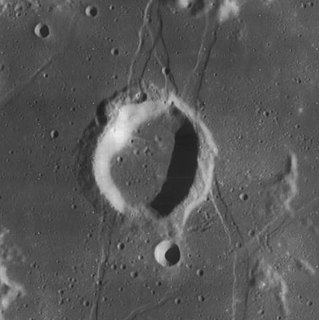
Ramsden is a lunar impact crater located on the western stretch of the Palus Epidemiarum. It was named after British instrument maker Jesse Ramsden. To the east-southeast is the crater Capuanus, and to the north lies Dunthorne.
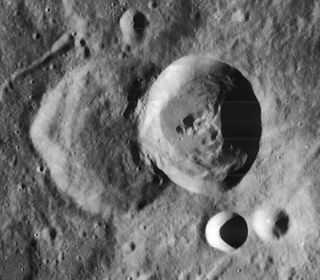
Sirsalis is a relatively young lunar impact crater located near the western lunar limb, to the southwest of the Oceanus Procellarum. The crater lies across a ridge that runs in a north–south direction. It has a sharp edge and a low central peak. The crater overlaps the slightly larger and older Sirsalis A to the west-southwest, and the two form a distinctive feature.

Ching-Te is a small lunar impact crater located in a mountainous area to the east of the Mare Serenitatis. It is a circular, bowl-shaped formation with no distinguishing features.

Marth is a small lunar impact crater located in the northwest part of the Palus Epidemiarum. It was named after German astronomer Albert Marth. To the northwest is the crater Dunthorne, and to the southwest lies Ramsden. This feature lies in a system of rilles named the Rimae Ramsden, and an interrupted branch passes only a few kilometers to the south of the rim.
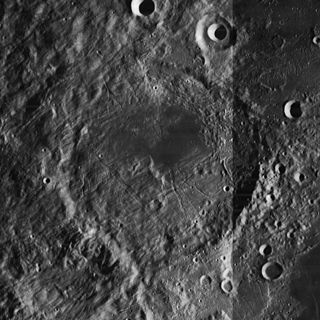
Riccioli is a lunar impact crater located near the western limb of the Moon. It lies just to the northwest of a larger crater, Grimaldi. To the southwest are the craters Hartwig and Schlüter that lie on the northeastern edge of Montes Cordillera, a ring-shaped range that surrounds Mare Orientale. Due to its location, Riccioli appears strongly foreshortened from the earth and is viewed almost from the side.

Al-Bakri is a small lunar impact crater on the northwest edge of Mare Tranquillitatis. It is named after the Spanish Arab geographer and historian Abu Abdullah al-Bakri. It is just south of the eastern arm of the Montes Haemus that borders the Mare Serenitatis to the north. To the east-northeast is the prominent crater Plinius. South of the crater are the rilles of the Rimae Maclear.

Bode is a small crater located near the central region of the Moon, to the northwest of the joined craters Pallas and Murchison. It lies on a region of raised surface between the Mare Vaporum to the northeast, Sinus Aestuum to the west, and Sinus Medii to the southeast. The crater was named after German astronomer Johann Elert Bode.

Ariadaeus is a small, bowl-shaped lunar impact crater on the western shores of Mare Tranquillitatis. It lies to the north of the crater Dionysius, and to the west-southwest of Arago. The crater is joined along the northeast rim by the slightly smaller Ariadaeus A, and the two form a double-crater. Its diameter is 10.4 km.

Boscovich is a lunar impact crater that has been almost completely eroded away by subsequent impacts. It is located west-northwest of the crater Julius Caesar, and south-southeast of the prominent Manilius. The crater floor has a low albedo, and the dark hue makes it relatively easy to recognize. The surface is crossed by the rille system designated Rimae Boscovich that extends for a diameter of 40 kilometres. The crater is named after Croatian physicist Roger Joseph Boscovich.

Cavendish is a lunar impact crater that is located in the southwest part of the Moon, to the southwest of the larger crater Mersenius. It lies between the smaller craters Henry to the west-northwest and de Gasparis to the east-southeast.

Mercator is a lunar impact crater that is located on the southwestern edge of Mare Nubium, in the southwest part of the Moon. It was named after 16th-century Southern Dutch cartographer Gerardus Mercator. It is located to the southeast of the crater Campanus, and the two are separated by a narrow, winding valley.

De Vico is a small lunar impact crater that is located in the southwest part of the Moon, to the south of the crater Sirsalis. To the west-northwest is Crüger. De Vico is a circular, bowl-shaped formation with a small, flat bottom at the midpoint. To the northwest is the lava-flooded remains of De Vico T. Beyond is a linear rille designated Rimae Sirsalis that follows a path to the northeast past the rim of Sirsalis.

Adams is a lunar impact crater that is located in the rugged southeastern section of the Moon, near the lunar limb. It lies just to the southwest of the crater Legendre. To the northwest are the craters Hase and Petavius, and to the southwest is Furnerius. To the southwest of Adams is a system of rilles designated the Rimae Hase. The longest of these rilles follows a course to the southeast.
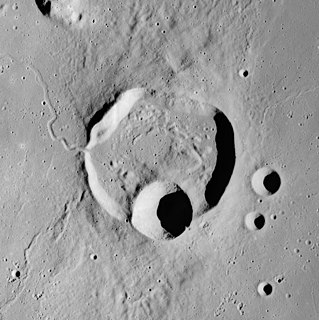
Krieger is a lunar impact crater on the eastern part of the Oceanus Procellarum. It is located to the north-northwest of the flooded crater Prinz, and north-northeast of the prominent ray crater Aristarchus. To the northwest lies the small Wollaston.

Campanus is a lunar impact crater that is located on the southwestern edge of Mare Nubium. It was named after Italian astronomer Campanus of Novara. It forms a crater pair with Mercator just to the southeast. Along the southern rampart of Campanus is the small lunar mare named Palus Epidemiarum. To the southwest is the small crater Dunthorne.
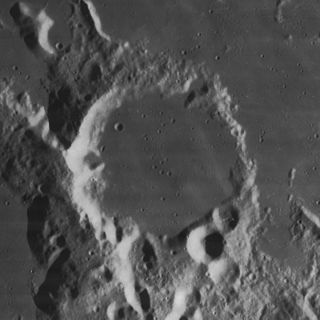
Capuanus is a lunar impact crater that lies along the southern edge of the Palus Epidemiarum. It was named after Italian astronomer F. Capuano di Manfredonia. The outer rim is eroded and indented by lesser crater impacts, with notches in the north, west, and southern parts of the rim. The interior floor has been resurfaced by basaltic lava, which is connected to the surrounding lunar mare by a narrow, crater-formed gap in the northern rim. Dotting the floor of the crater are a number of domes, which are believed to have formed through volcanic activity.

Elger is a lunar impact crater that lies along the southern edge of Palus Epidemiarum, the Marsh of Epidemics, in the southwest part of the Moon's near side. To the northeast is the flooded crater Capuanus, and farther to the northwest is Ramsden.
Fontana is a lunar impact crater that is located in the southwestern part of the Moon's near side, to the south of the Oceanus Procellarum. It lies to the west-northwest of the flooded crater Zupus. Midway between Fontana and Zupus is a rille system designated Rimae Zupus.

Lepaute is a small lunar impact crater that is located along the western edge of the Palus Epidemiarum, a minor lunar mare in the southwestern part of the Moon's near side. It was named after French astronomer Nicole-Reine Lepaute. To the east is the larger crater Ramsden, within a system of rilles named the Rimae Ramsden. This is an elongated crater feature that is longer in the north–south direction. The outer rim is only slightly worn, and the inner walls are simple slopes that run down to the level, featureless interior floor.





















